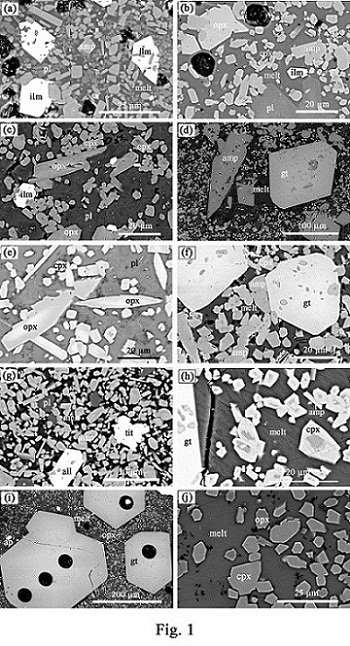Partial melting of lower crust at 10-15 kbar: constraints on adakite and TTG formationUpdate time:06 27, 2013
Vice Professor QIAN Qing and his team present the results of partial melting experiments at 10–15 kbar and 800–1,050℃ on a synthetic, trace element doped starting material resembling the lower crust compositions of Rudnick and Gao (2003) and Condie and Selverstone (1999) in major elements. The main aim is to investigate the major and trace element compositions of partial melts from anatexis of mafic lower crust as a function of residual phase assemblages. The experimental results are used to constrain the P–T conditions of adakite/TTG formation from mafic lower crust and to provide geological implications with emphasis on whether an overthickened crust is necessary to produce adakite/TTG magmas in such a tectonic setting.
Fig. 1 Backscattered electron (BSE) photomicrographs of run products. (Image by QIAN)
Fig. 2 Pressure–temperature conditions (red box; 10–12.5 bkar and 800–950 ℃) appropriate for formation of adakite/TTG from mafic lower crust. (Image by QIAN) Qian Q & Hermann J. Partial melting of lower crust at 10-15 kbar: constraints on adakite and TTG formation. Contributions to Mineralogy and Petrology, 2013, 165: 1195-1224 (Download Here)
|
Contact
Related Articles
Reference
|
-
SIMSSecondary Ion Mass Spectrometer Laboratory
-
MC-ICPMSMultiple-collector ICPMS Laboratory
-
EM & TEMElectron Microprobe and Transmission Electron Microscope Laboratory
-
SISolid Isotope Laboratory
-
StIStable Isotope Laboratory
-
RMPARock-Mineral Preparation and Analysis
-
AAH40Ar/39Ar & (U-Th)/He Laboratory
-
EMLElectron Microscopy Laboratory
-
USCLUranium Series Chronology Laboratory
-
SASeismic Array Laboratory
-
SEELaboratory of Space Environment Exploration Laboratory
-
PGPaleomagnetism and Geochronology Laboratory
-
BioMNSFrance-China Bio-mineralization and Nano-structure Laboratory

 Print
Print Close
Close

